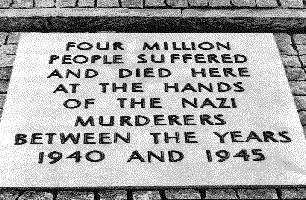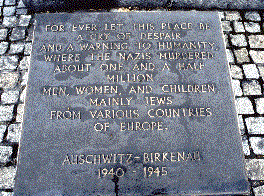The International Holocaust ControversyJudge Wennerstrom on the Nuremberg TrialsProf. Arthur Butz |
Plaques at Auschwitz | ||

| |||
| Before: Four Million | |||

| |||
| After: One and a half Million |
Trials, Jews and Nazis
We will have much to say of the NMT trials in this volume. However, the reader can grasp much of the spirit of these proceedings even from remarks made by some of the American judges who had been recruited by the U.S. Army to serve at Nurenberg. Understandably, these people were normally very reluctant to speak out publicly against what they observed. Thus, the remark of one of the judges in the Farber trial, that there were “too many Jews on the prosecution” was a privately expressed hint to the prosecution, certainly not intended for publication. However, the presiding judge in Case 7 (trial of German generals for alleged wholesale murder of hostages), Charles F. Wennerstrum, spoke out publicly and forcefully immediately after sentences had been pronounced.44
If I had known seven months ago what I know today, I would never have come here.
Obviously, the victor in any war is not the best judge of the war crime guilt. Try as you will, it is impossible to convey to the defense, their counsel, and their people that the court is trying to represent all mankind rather than the country which appointed its members.
What I have said of the nationalist character of the tribunals applies to the prosecution. The high ideal announced as the motives for creating these tribunals has not been evident.
The prosecution has failed to maintain objectivity aloof from vindictiveness, aloof from personal ambitions for convictions. It has failed to strive to lay down precedents which might help the world to avoid future wars.
The entire atmosphere here is unwholesome. Linguists were needed.
The Americans are notably poor linguists. Lawyers, clerks, interpreters and researchers were employed who became Americans only in recent years, whose backgrounds were imbedded in European hatreds and prejudices.
The trials were to have convinced the Germans of the guilt of their leaders. They convinced the Germans merely that their leaders lost the war to tough conquerers.
Most of the evidence in the trials was documentary, selected from the large tonnage of captured records. The selection was made by the prosecution.
The defense had access only to those documents which the prosecution considered material to the case.
Our tribunal introduced a rule of procedure that when the prosecution introduced an excerpt from a document, the entire document should be made available to the defense for presentation as evidence. The prosecution protested vigorously. General Taylor tried out of court to call a meeting of the presiding judges to rescind this order. It was not the attitude of any conscientious officer of the court seeking full justice.
Also abhorrent to the American sense of justice is the prosecution’s reliance on self-incriminating statements made by the defendants while prisoners for more than two and a half years, and repeated interrogation without presence of counsel. Two and one-half years of confinement is a form of duress in itself.
The lack of appeal leaves me with a feeling that justice has been denied...
You should go to Nuremberg. You would see there a palace of justice where 90 per cent of the people are interested in prosecution...
The German people should receive more information about the trials and the German defendants should receive the right to appeal to the United Nations.
Ironically, the validity of Wennerstrum’s attack on the low or non-existent standard of integrity maintained by the Nuremberg prosecution was confirmed even by the nature of Telford Taylor’s reaction to Wennerstrum’s statements, which were made in supposed privacy in Nuremberg for publication in the Chicago Tribune.
44. DuBois, 182. Chicago Tribune (Feb. 23, 1948), 1, 2; (Feb. 24, 1948), 3; (Feb. 25, 1948), 4; (Feb 26, 1948), 1, 8; (Feb. 28, 1948), 4, 8; (Feb. 29, 1948), 2; New York Times (Feb. 23, 1948), 5; (Feb. 25, 1948), 10; (Feb. 29, 1948), 10; (Mar. 6, 1948), 6.
Arthur R. Butz, The Hoax of the Twentieth Century, Castle Hill Publishers, 2003, pp. 44-45, first published by Historical Review Press, 1976.